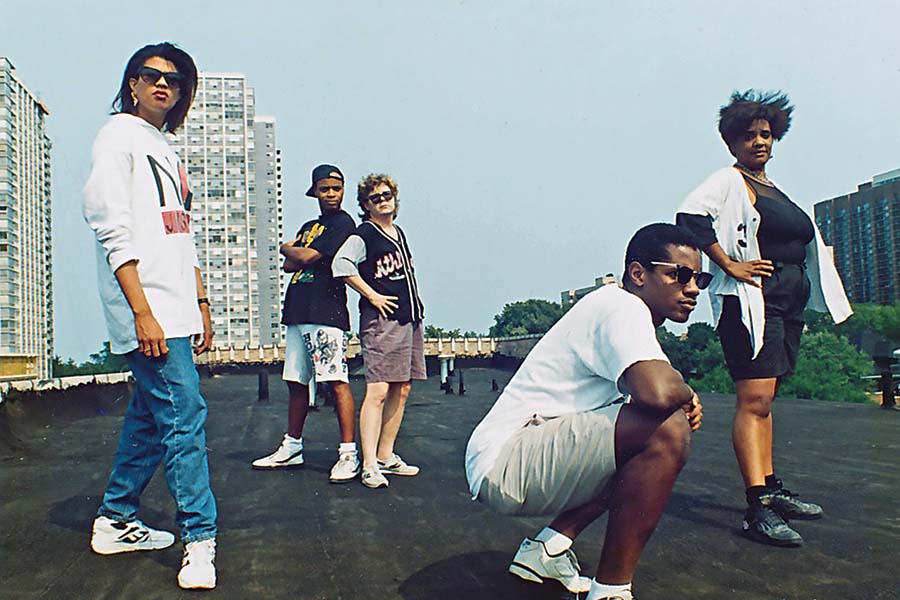“Everyone in Improv Troupe Balding,” read a 2012 Onion headline, with a photo showing a scrum of middle-aged white guys. The satiric story noted the guys’ collective pride in their accomplishments and their shared sensibilities, all while sidestepping their homogeneity and significant financial investment in their pastime.
The Onion’s parody hit on an uncomfortable truth about the improv world: For much of its history, improv has been a straight white man’s game. Anecdotal evidence abounds. Amy Seham’s history of underground improv, Whose Improv Is It Anyway?, shows that many women and people of color in the early improv scene felt estranged from all the “white guys in ties.” Native Chicagoan Shaun Landry, who co-founded the nation’s first African American improv troupe, Oui Be Negroes, recalls that during the late 1980s and early ’90s she could count the number of Black improvisers in the city “on one hand—and not even cover the entire hand.” And the improv luminaries on the Sgt. Pepper’s-style cover of Sam Wasson’s recent Improv Nation include only a handful of women and just two people of color.
Once upon a time, back in the ’50s and ’60s, improv was a tool; it helped Viola Spolin train actors, then aided Second City performers and directors in generating sketches. In the ’70s and ’80s, revolutionary guru Del Close reimagined improv as an art unto itself. By the ’90s, those ideas took flight at Close’s home theatre of iO in Chicago and among acolytes such as the Upright Citizens Brigade, who spread the improv doctrine to New York City, while the Groundlings, an offshoot of the Close-inspired troupe the Committee, held down the fort in Los Angeles.
Since then improv has only seen its cachet swell. With the help of “Whose Line Is It Anyway?,” TV creators like Larry David and Armando Iannucci, and superstars including Stephen Colbert and Tina Fey, it has gained more mainstream visibility. Agents and managers expect to see improv training on actors’ résumés; casting directors increasingly expect it in audition rooms. The Second City, which turns 60 this year, is a respected institution feeding performers to shows such as “Saturday Night Live” (and onward into movies and TV careers). Growth has been expansive for many formerly scrappy organizations such as the Upright Citizens Brigade. While forced to shutter one of its four theatres in February, the UCB still boasts three branches and a training center on each coast. And most major cities in America have some sort of improv theatre offering shows and classes to convert average citizens to the gospel of “Yes, and…”
With success comes additional scrutiny and accountability. In conversations for this story, producers, directors, and performers offered several reasons why underrepresented voices have traditionally shied away from improv: geographic distance, overt sexism or general disrespect, lack of visibility on the stage, lack of personal funds or free time to pursue art that doesn’t pay, lack of shared references with other improvisers, and feeling like a token onstage.
Improv may still skew white, but things are changing. These days many comedy theatres do some sort of outreach to discover new, untapped voices, and many offer some sort of scholarship to encourage those whose bank accounts can’t support an improv education.
Still, the improv world may make its most significant changes only when pushed. In the fall of 2015, performer Oliver Chinyere posted a story on Medium about quitting UCB over such issues as a house team audition that yielded no slots for people of color. News outlets picked up the story. Over email Chinyere—now based in London—agreed that the issue is not unique to UCB, and said there has been evidence of change at the theatre. Indeed a cursory glance at UCB’s house teams reveals that nearly every one has at least one person of color. And discussions spurred by the #MeToo movement about harassment and sexism in the comedy world led to some restructuring at organizations including iO and Second City.
The following folks are currently working to alter perceptions and expectations about improv. Some are longtime warriors, others are new to the scene. But all point toward a future in which the stage presents a more diverse mix of ages, nationalities, body types, skin tones, gender identities, sexual orientations, and, yes, even political affiliations.
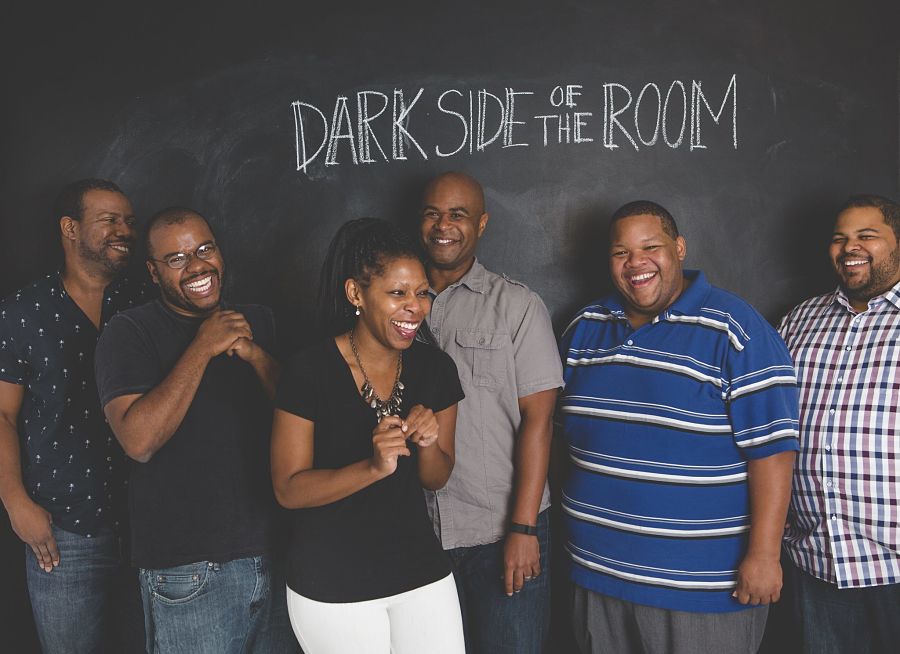
Ask Dad’s
Atlanta improv troupe Dad’s Garage Theatre Company, though founded in 1995, didn’t make representation and community engagement a true priority until 2010, the year current artistic director Kevin Gillese arrived from Canada. Since then Dad’s staff has been working to ensure that locals of Atlanta’s Old Fourth Ward neighborhood feel comfortable in and about the space. In a gentrifying, primarily Black neighborhood, Dad’s doesn’t just cast a diverse array of comics; it also connects with local schools and hosts roundtables for regional politicians. “We’re interested in making sure that the community grows with us,” says Dad’s associate artistic director Ed Morgan.
When Morgan first took classes at Dad’s in 2007, the demographics were what many expect at an improv theatre—i.e., “middle-aged white guys in Chuck Taylors and a couple of white women.” After an effort to increase the diversity of casting committees and to hold themselves to ideal cast breakdowns, the regular performers at Dad’s now have close to gender parity. The number of people of color in Dad’s ensembles has significantly increased too, though not quite as much as the theatre’s leaders would like. “There’s no one change you can make and everything is solved,” Morgan avers. “We never let ourselves get comfortable.”
Though Dad’s sees an economic return on these efforts—i.e., new audiences drawn by their African American troupe, Dark Side of the Room—diversity isn’t just about the bottom line. Dad’s old fans seem to be commingling and conversing with new ones, and Morgan says a diverse cast of improvisers can cover more sensitive topics, not fewer. If a joke feels off, performers hold each other accountable. “We love each other very much on a personal basis, and therefore it’s just loving correction,” says Morgan.
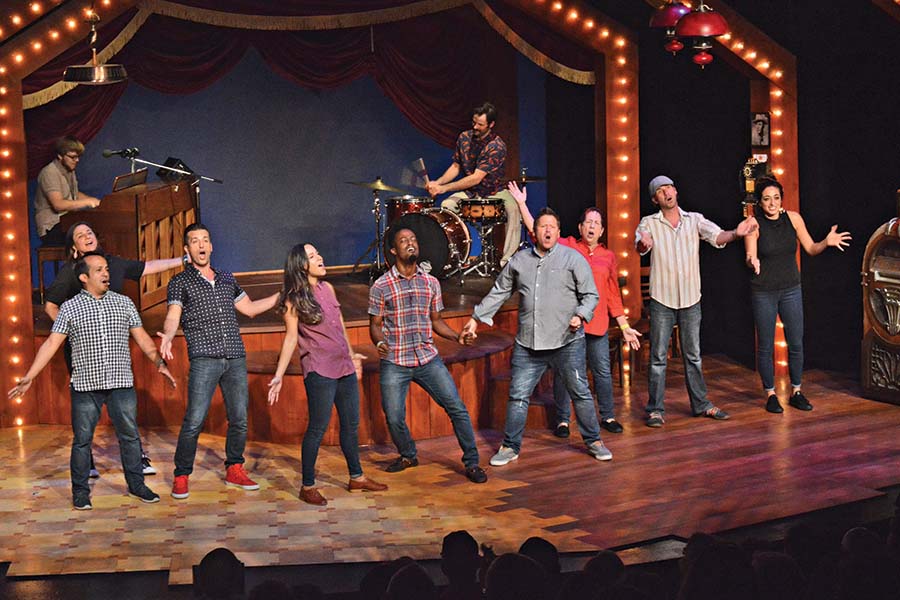
Think Global, Improv Local
Florida Studio Theatre of Sarasota’s resident improv troupe, FST Improv, includes Latinx and African American players, plus one performer of Middle Eastern descent. There are two gay cast members. Players’ ages range from 20 to 60; half are men, half are women, some are conservatives and some liberals. Given Sarasota’s demographic makeup—the most recent U.S. Census indicated the population was 75 percent white—the ensemble’s diverse makeup is impressive.
It didn’t happen overnight, however. Assembling this crew has taken the time and effort of both FST’s managing director, Rebecca Hopkins, and its director of improvisation, Will Luera. Before arriving in Florida, Luera worked for 12 years as artistic director at ImprovBoston. Though he felt in tune with his audience, he found playing to young, white, liberal Bostonians somewhat limiting. His humor, he says, had “fallen into Northeast elitism with everyone else.”
Late in his tenure at ImprovBoston, he had his eyes opened at an improv festival in Puerto Rico, where he encountered global teams and gurus (including Argentinian Omar Galvan) with novel outlooks on improv. Since his move to Sarasota, Luera has been looking not only to diversify his cast and expand his audience, but to connect to more “universal themes” by employing improv methodologies from around the world.
With FST’s resources and support, Luera can prioritize education and investment over ticket sales. His inclusivity efforts include casting that favors “intangibles” over résumé credits and “instant scholarships” that can embrace new talent without too much red tape. His initiatives have seen the artistic range of the company improve, and they’ve been good for business too. “More of your audience can see the ensemble and think, Hey, I see myself onstage,” says Leura. “Not only might they come see the show again, they might decide to take a class.”
Luera’s ensemble of improvisers aged 60 and over, Early Bird Special, and a bilingual collaboration with nearby Bradenton’s CreArte Latino theatre have given Luera an even wider reach in the community.
Safe Haven
Terrible men can be an inspiration. Just ask the proprietors of the new feminist comedy theatre the Ruby L.A. When L.A.’s Nerdist Theater found its proprietor pulling the plug, staffers Jen Curran, Lindsey Barrow, and Randy Thompson—who had been closely tracking the conversation about sexism and harassment in comedy stirred up by the #MeToo movement—decided to renew the lease in April of 2018 and restructure the theatre as a version of their comedic utopia.
On the surface the Ruby model parallels that of other comedy theatres across the country: improv and writing classes during the week, shows on the weekend. But anyone who reads their mission statement will see that the theatre is “driven by underrepresented voices in Hollywood” and that its comedy aims to “shine a light.” This mission is a draw in itself. As Barrow puts it, “A couple of people have told me, ‘This is the only place I can do comedy and know someone is not going to make an awful rape joke.’”
While the space in principle welcomes everyone, comedians who fear that their edgy comedy will be unwelcome on the Ruby stage may be right. To these comics, Barrow says, “We’re not silencing you, but this is not the right fit. Find another theatre.”
The Ruby offers only one eight-week improv class, in part because it’s intended less as a new-talent incubator than as a haven for performers seeking a home. Barrow notes that while UCB has made a push for more inclusion, in her opinion the comedy at UCB “can still be pretty bro-y and a little aggressive.” With a teaching staff that is half women and people of color, the Ruby has a student population that, Barrow estimates, is just 30 percent straight white males.
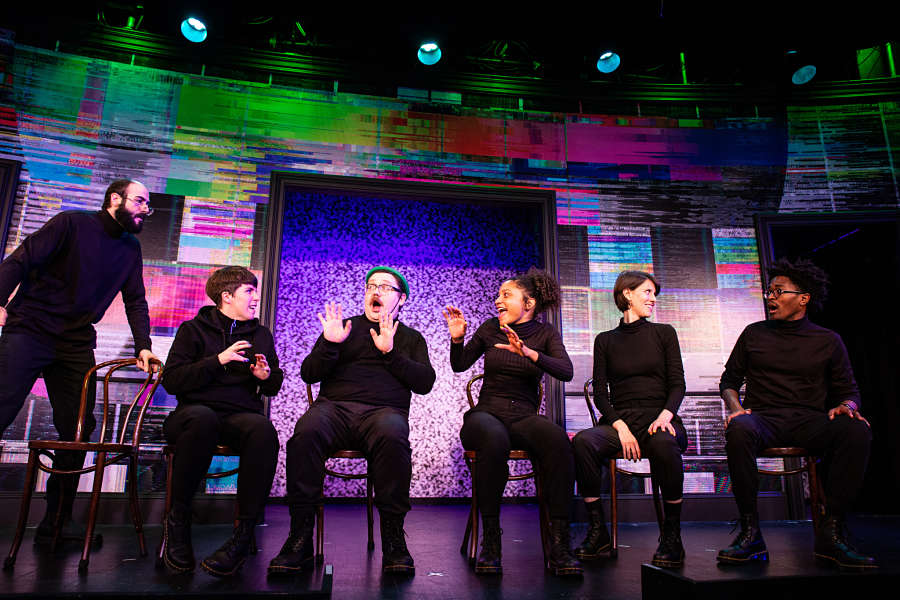
Incremental Change
In 1992 Andrew Alexander, CEO of Chicago comedy giant Second City, watched as his all-white troupe of improvisers struggled to make sense of the L.A. riots following the Rodney King verdict. It was a sign that the organization needed a broader range of experiences represented onstage. Soon after, Second City performer Frances Callier helped launch the theatre’s Outreach Program, which began hosting annual intensives for underrepresented communities. Slowly the student population began to look different, and more diverse shows popped up in the smaller Skybox space, while the Second City mainstage remained fairly status quo.
Revelations can be sudden, but change rarely comes quickly—especially at a big institution like Second City. “It’s incremental,” says Dionna Griffin-Irons, director of diversity and inclusion. “This art form is about taking risks. It’s okay to fail. In fact, we’ll find greater success if we fail.”
Griffin-Irons has been part of many outreach and inclusion efforts at Second City over two decades. She helped turn the annual intensives into a year-round program, and worked on word-of-mouth community outreach, a Black History Month review, and after-school sketch writing classes. Dividends have not always been immediately apparent, but the cumulative effect of her work can be seen even on the mainstage: Half of the cast are women, and two of the six players are people of color. On Second City’s e.t.c. stage, the “Gaslight District” show has a similar makeup. In its Up Comedy Club, there’s a feminist show titled “She the People.” Audiences are beginning to diversify too. And the Bob Curry Fellowship for improvisers of multicultural backgrounds has borne fruit: Fifty percent of its graduates come back to work at Second City in some capacity. Still, as Griffins-Irons says, “There are always more ways to open our doors.”
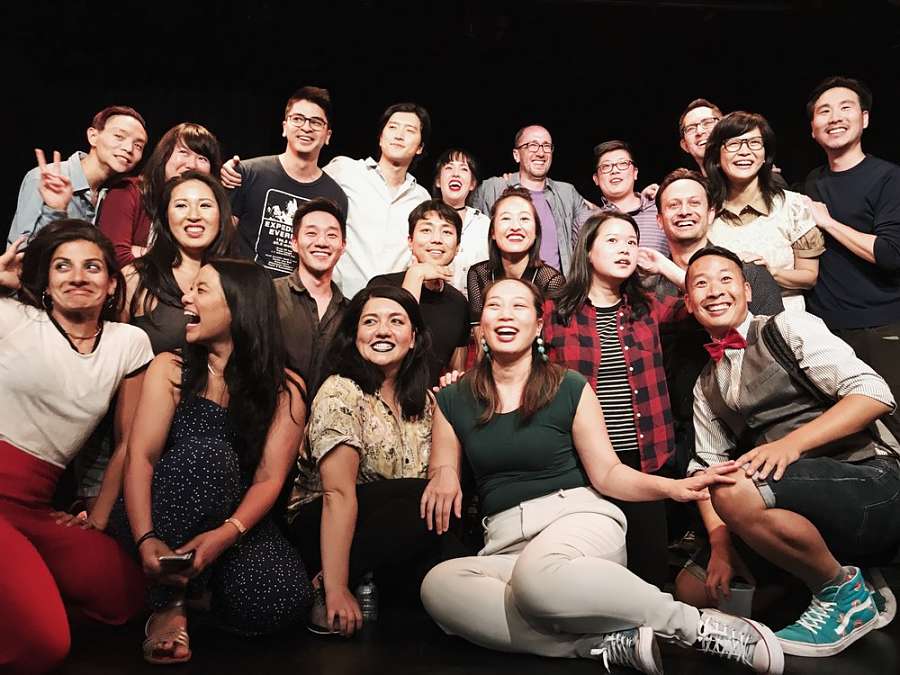
Producing Results
The first time Will Choi saw long-form improv, it featured the not-yet-famous Steven Yeun at the now-defunct iO West theatre. “It was a big deal to me,” says Choi. “He’s Korean American and I’m Korean American, and I just didn’t know that [improv] was something Korean people did.”
This epiphany served as his invitation. In classes at iO West and UCB in 2012, Choi began to envision an Asian American comedy showcase. UCB house teams only had two Asian Americans, but he knew enough indie performers to form his own teams. Choi called his first shows in 2016 “Scarlett Johansson Presents”—a cheeky jab at the white actor controversially chosen for the lead role in the U.S. film version of the Japanese manga Ghost in the Shell. Curiosity about this provocative reference surely helped bring the first audience of more than 300.
Since rebranded Asian AF, Choi’s show has regularly sold out 70 performances in L.A. and New York. Though initial audiences were primarily of Asian descent, Choi says that crowds now appear to be roughly “50 percent Asian, 50 percent everyone else.” Showbiz gatekeepers come too, with many participants landing auditions or representation. Choi also helps produce Filipino AF and South Asian AF to broaden the show’s horizons beyond its core East Asian participants. Since Choi’s successes at UCB, the theatre has made room for more shows that speak directly to underrepresented groups, e.g., Drag Race and Spanish Aquí Presents.
While Choi cracked the code at UCB, it’s worth noting that he is not alone in creating identity-based shows that could be programmed at any venue. There are troupes speaking directly to underrepresented groups in cities across the country, in comedy theatres of all kinds, that have been running longer than Asian AF. To name a few that have garnered attention beyond the boundaries of their home theatres: GayCo and Preach in Chicago, Blackout Improv in Minneapolis, and the lauded granddaddy of the L.A. scene, Jordan Black’s The Black Version. This assortment is just a smattering of the exciting (if slow) transformation of the scene.
As these examples indicate, encouraging diversity and representation is an ongoing effort. Moving beyond the status quo requires an investment of time and money, and as each of our interviewees affirmed, returns may be slow to arrive. But our subjects all agreed these endeavors enriched their shows and organizations in ineffable ways.
To those theatres and producers still mulling the possibilities, Ed Morgan points out that even small actions trump good intentions. “If you’re in a theatre and don’t know where to start—do what you can,” he suggests. “Trying is better than assuming it will just work itself out.” In other words, say yes to new blood and new perspectives however and whenever possible, and wait for a chorus of voices to respond, “Yes, and…”
Matthew Love is a writer and sometime improviser based in Brooklyn.

